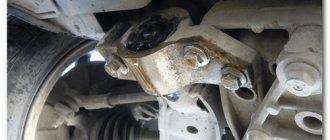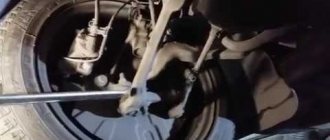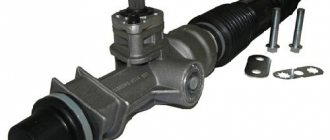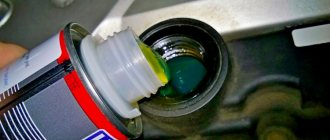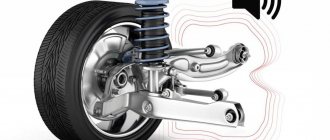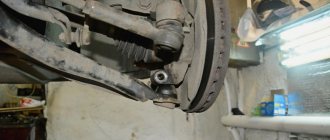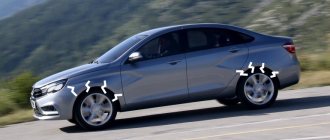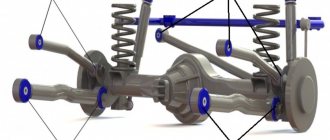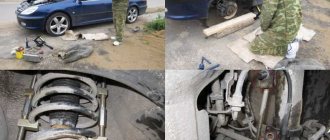Why knock?
It’s easier to list what can’t knock there. But in order to diagnose and identify the causes of knocking with minimal time, you will still have to comprehensively identify potential sources of sound:
- the suspension itself, or rather its guide vane;
- springs, that is, elastic elements;
- damping devices known as shock absorbers or struts;
- transmission wheel drives;
- steering components and parts;
- hubs with bearings;
- anti-roll bar with its own struts;
- brake mechanisms;
- fastenings and other parts related to the engine;
- any threaded fasteners or press fittings.
Naturally, not all of the above can be attributed to suspension parts, but there is no doubt that any knock in the suspension when driving over uneven surfaces will be attributed to it. It can be justified that the bumps should be really small, since on a large wave the parts experience accelerations that last longer, but are smaller in magnitude, and therefore may not knock.
Inspecting the car, what you need to pay attention to first
It may happen that after a long search for the sources of knocking, it will not be pleasant to find out that the problem is not in the suspension, but in the interior of the car.
Therefore, the first thing you need to do is check if there is anything knocking inside the car, check the glove compartment, cup holders, instrument panel elements. Next, see the suspension elements.
Check:
- Engine protection;
- Silent blocks;
- Front support bearings;
- Shock absorbers - struts and springs. We recommend reading why the shock absorber is knocking>;
- Ball joints;
- Steering rack;
- Steering tips;
- CV joints and axle shafts;
- Brake pads;
- Calipers;
- Wheel bearings;
- Engine support cushions;
- Anti-roll bar bracket and bushings (if equipped);
- Muffler and catalyst (they can especially knock on the body when cornering);
- Other reasons are bursting of side members, beams, loose wheels, mud flaps, etc.
It's the suspension that makes the sound.
Usually we can talk about this for sure only after diagnosis. At the stage when all that remains is to replace the faulty parts. Otherwise, by trial and error, you can move ad infinitum, and then still find a forgotten glass bottle rolling along the bottom of the front glove compartment, or other numerous exotic cases from repair practice.
Levers and articulations
Each guide vane arm begins and ends with a hinge. They can be rubber-metal (silent blocks) or rigid (ball joints and supports, bearings). As a result of wear, any of them can knock.
In terms of frequency of occurrence, ball joints hold the lead. As the name suggests, they are a spherical tip rotating in a metal housing with nylon liners. The bushings are pressed with springs, the fit is tight, and the new part works without play, that is, it cannot knock. As the balls and bearings wear out, a gap forms, the part gains unintended freedom, and a knock is heard in the suspension on small irregularities.
Diagnostics here consists of applying force in the opposite direction from the joint prestress. This depends on the kinematics of the suspension; sometimes the pin needs to be pulled outward from the body, at least with the help of a mount, but occasionally in the opposite direction. For example, in a MacPherson-type suspension, the lower support works differently than in a classic double wishbone.
Silent blocks usually creak, not knock. But they can also be brought to such a state that all the rubber has already run out, and the blows are metal on metal. One glance is enough to reveal the catastrophic nature of the situation, in which it is often necessary to change the lever assembly.
Stabilizer
There are usually two places on the anti-roll bar where wear can occur. These are bushings for attaching to the body or subframe and struts. The bushings are a collapsible silent block, in which it is enough to replace the rubber elastic element. Although in severe cases such wear forms on the stabilizer bar itself that replacing the bushings is not enough; a new large part will be required.
Stabilizer links are a very weak point on all cars. They experience heavy loads, but are compact. It doesn’t matter how they are designed, on the basis of ball joints or with rubber elements, the assemblies are always changed. Nobody at the factories is going to strengthen them; the parts are simple, inexpensive, can be diagnosed by simply shaking the rack rod, and therefore are considered consumables.
Springs and shock absorbers
Knocks can be heard very rarely from the springs.
Usually only in case of fatigue failures of the outermost turns. It’s not even always noticeable, but it sounds loud while driving, and the car’s posture changes even more noticeably. The body seems to sit on one side, and often on both, since the springs like to break in pairs. At the same time, you need to replace the cushions on which the spring rests on its upper and lower sides. Shock absorbers make themselves known much more often. Both by themselves and in places where they are attached. In order of frequency of occurrence, several sources can be identified that cause knocking in the front suspension on small bumps:
- the upper supports of the front struts in the MacPherson suspension, where the bearings and rubber couplings are destroyed;
- lower and upper silent blocks of shock absorbers of classic suspension on A-shaped triangular arms;
- internal failures in the shock absorbers themselves.
Diagnosis is usually carried out by touching the suspicious area with your hand while rocking the front of the car. Play in the upper supports, knocks inside the shock absorber or wear on the rubber elements are clearly visible. Moreover, all this is not noticed immediately, the car manages to drive in a faulty state, and the sounds are accompanied by visual effects, oily sweating of the bodies, sticking out of the body from the body higher than usual, or rubber rags coming out of the silent block clips. Racks, like supports, are usually replaced as an assembly; it is illogical to leave rusty and tired metal, even if it is not yet broken.
Assessing the condition of shock absorber struts
The shock absorber itself very rarely makes extraneous sounds.
And if this has already happened, therefore, the part is in extremely unsatisfactory condition, and in the future simply cannot be used on the vehicle. The simplest and most common method of checking shock absorbers is to rock the car from the side where the suspected source of the problem is located. If, at the time of rocking, the car body smoothly takes its original position and there is no extraneous noise, therefore, the shock absorber strut is in good condition. If, after swinging, the shock absorber has difficulty lifting the car body, most likely the level of working fluid or gas in it has significantly decreased. This may be caused by a leak in the seal of its housing. In addition, when braking or coming into contact with road potholes, the faulty element cannot completely dampen body vibrations, as a result of which they are clearly felt in the cabin. If during visual diagnostics it was not possible to determine whether the shock absorber is working or not, it must be removed from the vehicle for a detailed search for the problem.
Features of the behavior of front wheel drives
They consist of a splined shaft, two constant velocity joints (CV joints) and elastic boots made of thermoplastic or rubber. Each hinge is usually made according to a six-ball design, where the trajectories of the balls’ movement along grooves cut into the cages are thought out with high precision. The balls are separated by separators.
Problems with the CV joint manifest themselves as crunching noises when turning the steering wheel and accelerating. But if no attention is paid to this, then the backlash increases to such an extent that the hinges begin to rattle in the manner typical of suspensions, that is, on small irregularities. This is already a dangerous symptom; the drive can collapse at any moment. It is urgent to carry out diagnostics and change the CV joint or drive assembly if element-by-element replacement is not provided.
Drives rarely survive natural wear and tear; usually it all starts with a rupture of the protective cover. The hinge loses its seal, grease comes out, and water and dirt appear in its place. Due to its high accuracy, the unit does not tolerate this for long; after a few hundred kilometers it is no longer suitable for use. Visually, this is clearly visible on the pit or lift by traces of grease and cracks in the cover.
In addition to “grenades,” the source of knocking in the drive can be the splined joints of the shaft. When backlash appears, a massive part cannot work silently and will make a knocking sound when driving in neutral gear. This can be determined by shaking the shaft in a perpendicular direction; the gap should almost not be felt. Unfortunately, if the shaft wears out, the drive assembly will most likely need to be replaced.
How to fix the situation?
First you need to determine the cause of the knocking. The situation can be corrected by replacing the non-functioning element, since it is impossible to disassemble the shock absorber. By the way, replacement should only be done in pairs. That is, if you changed the shock-absorbing device on the left side, change it on the right as well.
Some car enthusiasts still try to make minor repairs to a defective item. To do this, they cut off the rolling of the body. After cutting, you can remove the piston with rod. This allows you to check the rod and pistons and, if necessary, replace them - and also add new working fluid. During assembly of the mechanism, the cut rolling area will have to be welded. This is a complex process - it is much easier to buy new elements and install them.
To prevent knocking, it can be recommended to avoid “forcible” operation of the car. It is clear that the roads need to be chosen more evenly - it is hardly worth talking about. Pay special attention to the condition of the oil. In cold weather, you should not pick up speed too quickly, because at the very beginning of movement, the temperature of the working fluid corresponds to the air temperature. Excessive oil viscosity is a common cause of valve disc failure. To avoid this, it is better to pick up speed a few minutes after the start.
The service life of shock-absorbing elements is limited. But to prevent them from breaking prematurely, you must follow the rules for operating the car.
Steering linkage and steering gear
This system has many joints, any of them can knock:
- steering tips, these include everything said above about ball joints, the design is identical;
- ball joints of steering rods in conjunction with the rack and pinion steering mechanism, usually these parts can be replaced separately from the ends;
- guide bushings at the exit from the rack housing; the rack will need to be rebuilt and the repair kit replaced;
- connecting the steering shaft drive gear to the rack; sometimes it is possible to tighten and adjust the gap;
- the gap between the worm and the sector in the worm steering mechanism is eliminated by adjustment.
The steering column may also knock, but this sound is quite easily localized and is not disguised as knocking in the suspension.
Replacing a shock absorber without zip ties
If there are no ties, you can try to replace the shock absorber without using tools, but it should immediately be noted that this method is quite risky, although with due care and attention everything should work out. Here the disassembly order is as follows:
- open the hood, unscrew the nut securing the cup above the support bearing;
- remove the wheel, jack up the steering knuckle from below, it is necessary that the spring compresses, the shock absorber rod rises from above along with the nut securing the support bearing;
- Having unscrewed the fasteners from above, unscrew the bolts and nuts securing the steering knuckle to the shock absorber strut, lower the jack, knock out the bolts - first the top one, it will come out freely, when knocking out the bottom bolt, the shock absorber strut will jump down a little under the remaining spring tension. But the spring will not shoot strongly, since it is almost free and can be rotated quite easily by hand;
- Now all that remains is to remove the shock absorber by pulling it down. The spring and support bearing will come off immediately, since the nut does not connect them to the strut; it is already unscrewed.
Disassembling the shock absorber strut without ties is not too difficult; it is more difficult to install the shock absorber in place by tightening the spring using a jack. But the master who managed to disassemble the shock absorber in such a way can figure out on the spot how to install all the parts in place. The most important thing is to compress the spring so that the bolts fit into the holes in the steering knuckle. It may be necessary to remove the tie rod and ball joint from the steering axle to allow the knuckle to move further down.
Wheel bearings
The modern design of these units with double-row ball or roller bearings does not require adjustments, is reliable and operates with virtually no play. Although there is no tension there either, a slight play can be felt. But if it increases to a clearly noticeable size when the suspended wheel rocks, then the bearing must be replaced immediately. Otherwise, it will begin to heat itself up and may quickly collapse. The knocking is clearly noticeable when driving, often accompanied by a howl from the bearings that have begun to collapse.
There are also earlier designs where the bearings require periodic adjustment. It boils down to bringing the gap with the hub nut to the value specified in the instructions, after which the nut is locked. The gap may increase if the bearings are in good working order, which will manifest itself as if the front suspension is knocking.
Additional reasons
If you check the parts listed above, but the knock from the rear still remains, you should pay attention to the following things:
Stopping support. Here they proceed as in the case of the front suspension. When it is skewed, the caliper will make a loud sound, so diagnosing this malfunction is not difficult.
Wheel bearing. You need to jack up the car completely or just the wheel you want to check. When rotating freely, the bearing should not make noise, knocking or creaking noises. When checking, the brake pad may rub against the disc, the sound of which is very similar to a squeak. Therefore, be careful when diagnosing.
Front brakes
Disc brakes, especially those with a floating caliper, often become the source of a clearly audible knocking noise. Parts are subject to cyclic overheating and exposure to all road troubles in the form of water and abrasives, which causes them to wear out and corrode. And the pads themselves are not secured by anything, they are only pressed by weak springs in their guides.
Diagnostics is difficult, since there are always gaps here, and the necessary accelerations can only be created while driving. In general, you can follow the rule that if the knocking noise disappears when you press the brake pedal, then it is either the caliper or the wheel bearing, but the second one is easy to check separately.
Repair comes down to replacing the pads, guides, lubricating parts, but if this no longer helps, then you will have to reject the caliper assembly. Having first checked all other causes of knocking in the front suspension, since the parts are expensive.
Knock in the front suspension of Renault Logan (ball joint is faulty)
The cause of knocks and squeaks is often wear and tear on the ball joints. This is a very important part in the form of a hinge that connects the wheel hub to the suspension arm. True, ball joints usually knock only on rear-wheel drive cars with a simple suspension.
To verify that the ball joint is faulty, you need to hang the wheel, press the brake pedal and try to turn the wheel left and right. If there is play and knocking, then the ball needs to be changed. It must be said that in some cars, such as the Lada Granta or VAZ 2110, the ball joint is bolted on, so replacing it is not difficult.
If no play is detected, you need to check the condition of the boot. The fact is that often the cause of noise in ball joints is dirt getting under the joint. Therefore, you need to add lubricant to the hinge and replace the boot.
Other sources
Sounds masquerading as suspension can be created by any part of the power unit under the hood, and even by any loose fasteners. In this case, great difficulties arise in diagnosis due to the significant volume of checks. It can be very difficult, after going through the entire suspension, steering, brakes and half of the engine, to eventually find a fragment of a destroyed catalyst hanging in the exhaust system pipes or a driven disc damper spring flying along the clutch housing.
Particular attention should be paid to the power unit supports, which elastically separate the engine and transmission from the body. If one of them sank, then touching on bumps is possible anywhere. Body parts, such as a bumper, fender liner, or even the hood, can also rattle due to lost support bushings.
Not all drivers react adequately to such a knock in the front suspension on small bumps. Some continue to adhere to the old rule that good sound will manifest itself. Undoubtedly, this will happen, but even without talking about safety, we can accurately predict that the consequences will cost more than prevention.
We are finalizing and selecting supports and cushions for the rear pillar
The stock rear strut on a VAZ 2110 is mounted in the upper part through a disc washer 3 and two strut rod pads 6 in the figure below. So, often due to the fact that the dimensions and material of the rod cushions (donuts, as garage tuning experts call them) do not correspond to the original or wear of the shock absorber, a knocking, creaking and grinding sound appears in the cup, which cannot be removed by other means.
Theoretically, they are the same, both upper and lower, catalog number 2110-2915450. At the same time, cushions from classic Zhiguli 2101-2905450 were installed on exactly the same pillars of the VAZ 2109-2108. They are slightly different in configuration, but may well be interchangeable.
As a rule, the upper cushion wears out, so third-party manufacturers, like СС20, have developed their own methods of combating knocking - they suggest installing two instead of three parts (two cushions + bushing). The bushing with the lower cushion is made integral, and the upper cushion is made separately.
Bushing and cushions from SS 20
At the same time, the СС20 bushing is rubberized so that the upper cushion does not wear out so much. Most of the car enthusiasts who installed such a kit were satisfied, the knocking disappeared, and the handling improved due to the fact that the rod play was eliminated.
In the case when we feel sorry for the money to buy a combined SS20 pillow, we can do it even simpler - cut off half of the stock pillow before installing the disk washer. This allows the cut cushion to constantly compress the rod regardless of wear. True, sometimes you have to tighten the shock absorber rod nut.
In this way, you can at least partially overcome the knocking of the rear shock absorber strut on the VAZ 2110.
Self-diagnosis method
For self-diagnosis, you will need the help of another person.
Having chosen a flat surface, put the car on the handbrake and remove the protective covers from the glasses.
Have an assistant rock the car to set the shock absorbers in motion, and observe the behavior of the bearing yourself. The malfunction of the unit can be judged by:
- by the presence of backlash;
- when knocking or other sounds appear in the bearing area.
Make similar observations when your partner rotates the steering wheel, and then repeat the manipulations with the second pillar.
Replacing a strut bearing requires special tools and some plumbing skills. The best option would be to entrust the work to specialists, but if you are used to doing everything yourself, then you can do it yourself, but this is a topic for another article.
Analysis of typical complaints
The advice given at the beginning, to understand when the tapping occurs, makes it somewhat easier to find the cause. But this recommendation is effective only with a comprehensive diagnosis. For example, the mere fact of clanking in the pits is not enough; you need to listen to what is happening when the wheels are turned and whether there are any sounds in place.
If the test is done, go through common complaints.
- The noise only appears when the steering wheel is turned. If nothing is transmitted to the steering wheel, then see “ball” in more detail. Perhaps it is not tightly attached to the steering knuckle or lever. For example, bolts are often forgotten to be tightened during wheel alignment.
- The knock comes from the steering wheel. This is either a rack or a cardan on the shaft. If this only occurs on washboards and other irregularities, inspect the control shaft telescopic connection. Pay attention to the rack and pinion mechanism - the nuts securing it to the subframe or body may be loose.
- The rattle is only on the straight line, quiet in turns. Rack, cardan, ball joints.
